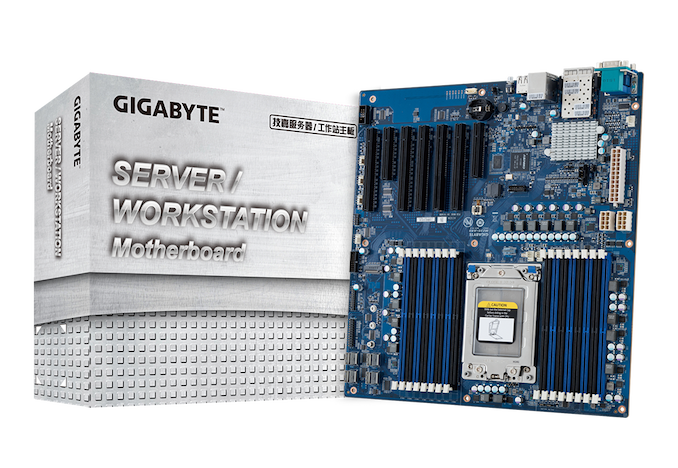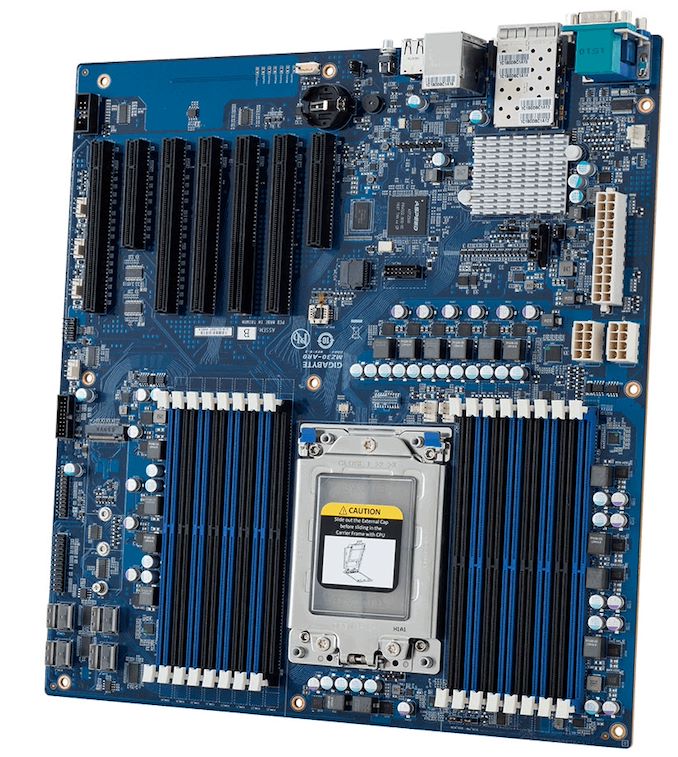The GIGABYTE MZ31-AR0 Motherboard Review: EPYC with Dual 10G
by Gavin Bonshor on March 25, 2020 1:15 PM EST
The workstation and server markets are big business for not only chip manufacturers such as Intel and AMD, but for motherboard vendors too. Since AMD's introduction of its Zen-based EPYC processors, its prosumer market share has been slowly, but surely, creeping back. One example of a single socket solution available on the market is the GIGABYTE MZ31-AR0. With support for AMD's EPYC family of processors, the MZ31-AR0 has some interesting components including its 2 x SFP+ 10 G Ethernet ports powered by a Broadcom BCM57810S controller, and four SlimSAS slots offering up to sixteen SATA ports.
GIGABYTE MZ31-AR0 Overview
As it stands, AMD has two versions of its EPYC range on the market: the first generation Zen series (called Naples), released in June 2017, and the Zen 2 based EPYC chips (called Rome). Each processor from AMD's EPYC families has support for 128 PCIe lanes and up to 2 TB of system memory operating in eight-channel mode.
Despite the GIGABYTE MZ31-AR0 being a server motherboard, it uses the regular E-ATX form factor, with with a single SP3 socket that, depending on the revision of the board, supports Naples (rev 1.x) or both Naples and EPYC (rev 2.x). This ranges from base 8 cores 16 thread model (EPYC 7251), all the way to a 64 core and 128 thread variant (EPYC 7742).
EPYC is focusing on both performance and IO, and so along with a lot of PCIe lanes on offer, the MZ31-AR0's primary features includes a Broadcom BCM 57810S dual SPF+ 10 G Ethernet controller which adds two 10 G ports onto the rear panel. For maintenance, an Aspeed AST2500 powered remote management controller provides BMC functionality, with a D-sub 2D video output with a dedicated Ethernet port for direct access.
Both revisions of the board are limited to PCIe 3.0, even with Rome, but the board makes the most of the available PCIe 3.0 lanes. The GIGABYTE MZ31-AR0 has four full-length PCIe 3.0 x16 slots, one full-length PCIe 3.0 x8 slot, with a further two full-length PCIe 3.0 x8 slots given this board a total of seven full-length slots. This is an impressive array of PCIe support and is equipped to make the most of the 128 lanes available from the processor. Equally impressive is sixteen memory slots set up in two banks of eight slots either side of the SP3 socket which offers eight-channel support. These slots support both RDIMM and LRDIMM DDR4 modules up to a maximum capacity of 2 TB, with DDR4-2666, DDR4-2400, and DDR4-2133 all supported.

GIGABYTE MZ31-AR0 Block Diagram
For storage, the GIGABYTE MZ31-AR0 is well-equipped with four SlimSAS ports with each slot supporting four SATA drives, with a combined total of sixteen available for use. Interestingly, the MZ31-AR0 is equipped with a single PCIe 3.0 M.2 slot. Some users may have expected a second M.2 slot due to the board's large E-ATX form factor, but alas that is not the case. Focusing on the design, the board layout implies it would be more than suitable for rackmount deployment in a 1U chassis, which it is, although it can also be used in a permitting chassis that features E-ATX support. The positioning of the single 24-pin motherboard and two 8-pin CPU 12 V ATX connectors fit in line with support for 1U chassis, with GIGABYTE offering its own 1U solutions for users to capitalize on. The SP3 socket is rotated with this in mind for better airflow in a server situation.
From a performance perspective, we compared the MZ31-AR0 against an ASRock server model as well as other 16-core Zen compatible boards. Everything is in line with the competition - POST times are higher than anticipated, but this can be put down to the BMC initialization process. The performance in relation to power consumption is also a little higher than the ASRock model we tested, but it is EATX (versus ATX) and is pretty stacked, to say the least.
The GIGABYTE MZ31-AR0 currently retails for $565 at Amazon, and as a result of its current price point has a couple of competitive rivals on the market. One such example is the Supermicro MBD-H11SSL-NC which retails for $470 at Newegg, although with a much lesser networking configuration, and with fewer memory slots. Another example is the ASRock Rack EPYCD8 model with a current selling price of $460, which is in a similar with Intel dual 10 G Ethernet but has fewer memory slots.
Both of the Supermicro and ASRock examples are also ATX, whereas the GIGABYTE MZ31-AR0 is E-ATX, and as a result has more space to include the better memory support and premium dual 10 G SPF+ networking which it includes. For the extra $100 over the ASRock and Supermicro models, the MZ31-AR0 looks like a solid choice based on value and specifications, which in this area given the pricing of AMD's EPYC Zen-based processors, is a very worthy trade-off against the competition.
Read on for more extended analysis.











37 Comments
View All Comments
xyvyx2 - Wednesday, March 25, 2020 - link
physically the same, but not compatible :(https://en.wikipedia.org/wiki/Socket_sTRX4
Operandi - Wednesday, March 25, 2020 - link
Looks like the perfect board for my home Pfsense build. In all seriousness though looks like a pretty baller single socket Epyc board if only I had something lined up that could use it.Deicidium369 - Sunday, April 12, 2020 - link
a door stop would be an appropriate use for it - unlikely AMD would have the drivers ironed out.MenhirMike - Wednesday, March 25, 2020 - link
Does anyone know if it's possible to use Unbuffered ECC RAM with EPYC? Thinking of upgrading from a Threadripper to an EPYC for a Server, but I don't want to rebuy RAM as I already got enough DDR4 ECC UDIMMs.Slash3 - Wednesday, March 25, 2020 - link
Some Tyan boards seemingly support it from their spec sheets, but it's something that most reviews don't cover, unfortunately.Patrick at Serve the Home has also mentioned support on some older boards, but unfortunately he didn't mention any specific models in the one comment I was able to dig up on their forums.
MenhirMike - Wednesday, March 25, 2020 - link
Also, curious if the board supports bifurcation - the lack of M.2 Slots would make it perfect for e.g., an ASUS HYPER M.2 X16 or Supermicro AOC-SLG3-2M2 card, but for that it needs to support bifurcation of an x16 into 4x4 or an x8 into 2x4 slots.Slash3 - Wednesday, March 25, 2020 - link
The Hyper M.2 is long enough that you wouldn't be able to insert the card into the first five slots, which is a bit of a bummer. I can't confirm bifurcation support but I'd be very surprised if it didn't have it.phoenix_rizzen - Thursday, March 26, 2020 - link
We built our first iSCSI storage box around this motherboard. Have nothing but great experiences with it, and the IPMI implementation is light-years beyond what Supermicro supports (the GB IPMI is fully-web-enabled, using HTML5 KVM/console redirection, compared to the horrid Java implementation that Supermicro uses).The only downside if the SlimSAS connectors. It's very easy to find SlimSAS-to-SATA connectors (even comes with some in the box). Pain in the ass to find SlimSAS-to-SFF8084 connectors to connect to multi-lane, direct-attach backplanes! They exist, but nobody actually carries them (at least nobody that we could find in North America). Had to get them from a cable maker in China, which took the very slow boat to arrive.
For our first build, I messed up the model number for the backplane, ending up with an SAS expander version, so we had to use an HBA anyway.
For our second iSCSI storage server, we switched to the MZ01-CE0 motherboard. This includes 10GBase-T ports instead of SFP+. Other than that, it's virtually the same board. Got the right model backplane, and the SlimSAS-to-SFF8084 cables, giving 16 SATA connections direct off the motherboard.
For our next ZFS storage server, we'll be using MZ01-CE0 in a 2U chassis, running the OS off the motherboard connectors, with LSI/Broadcom/whoever-they-are-now HBAs with external connectors going to multiple 45-bay storage chasssis. That setup works great with all the extra PCIe lanes. :)
fazalmajid - Friday, March 27, 2020 - link
What OS do you use for your ZFS/iSCSI servers?phoenix_rizzen - Saturday, March 28, 2020 - link
FreeBSD